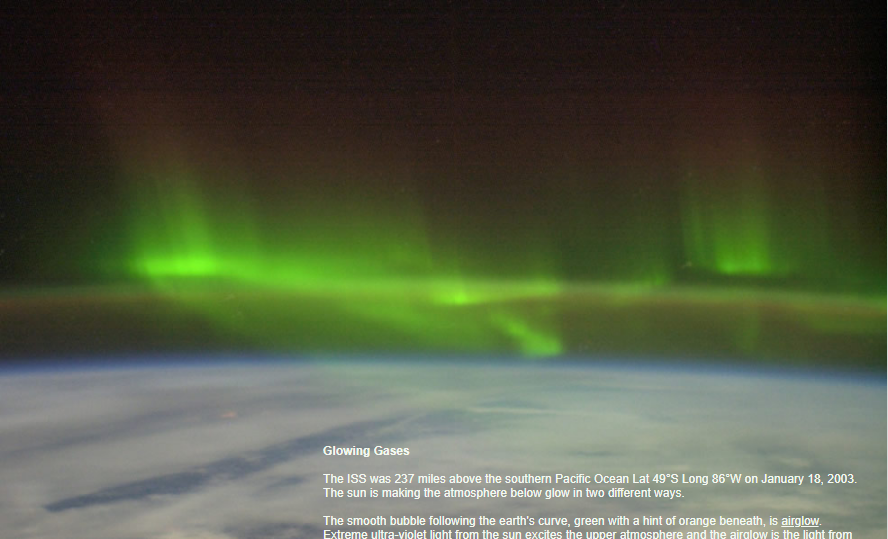Aurora Borealis and Airglow seen from the ISS
Aurora Borealis and Airglow seen from the ISS
When it comes to observing the Earth from space, the International Space Station (ISS) provides a unique vantage point. On January 18, 2003, while positioned 237 miles above the southern Pacific Ocean at latitude 49°S and longitude 86°W, the astronauts on board the ISS witnessed a captivating display of atmospheric optics: the Aurora Borealis and airglow. These mesmerizing phenomena are both caused by the interaction of sunlight with the Earth's atmosphere, but they manifest in distinct ways.
The first phenomenon observed is known as airglow. It appears as a smooth, greenish bubble following the curve of the Earth, with a touch of orange underneath. Airglow is produced when extreme ultraviolet light from the sun excites the upper atmosphere. In particular, it stimulates oxygen atoms (and potentially sodium atoms) to emit light. Even after darkness falls, these excited atoms continue to radiate their luminosity. The ethereal glow of airglow adds an enchanting ambiance to the night sky.
Meanwhile, towering above the airglow, the astronauts witnessed the awe-inspiring Aurora Australis. This magnificent spectacle consists of tall, spiky formations, emanating a vibrant display of colors. Similar to airglow, the Aurora Australis also arises from excited oxygen atoms in the upper atmosphere. However, in this case, the atoms become energized through bombardment by energetic electrons. These electrons originate from solar outbursts and become trapped in the Earth's magnetotail. Magnetic reconnections then occur, accelerating the electrons downwards towards the auroral ovals, resulting in the breathtaking auroral display.
The coexistence of airglow and auroras provides a captivating glimpse into the intricate interplay between our planet and its surrounding space environment. From the ISS, astronauts have a front-row seat to witness these celestial phenomena in all their glory. These observations not only inspire awe and wonder but also contribute to our understanding of Earth's atmosphere and the effects of solar activity on our planet.
It is important to note that the image accompanying this article is courtesy of the Image Science & Analysis Laboratory at NASA's Johnson Space Center. The ISS serves as a valuable platform for capturing stunning visuals of the Earth and its atmospheric optics, offering a unique perspective that enhances our knowledge and appreciation of our planet's beauty.
In conclusion, the Aurora Borealis and airglow observed from the ISS provide captivating insights into the complex interactions between solar radiation and Earth's atmosphere. The ethereal glow of airglow and the majestic display of the Aurora Australis demonstrate the dynamic nature of our planet's atmospheric phenomena. As we continue to explore and study these celestial events, we deepen our understanding of Earth's delicate balance and the intricate mechanisms that shape our planet's atmospheric optics. The ISS remains an invaluable platform for furthering our knowledge and appreciation of these awe-inspiring wonders.

Glowing Gases
The ISS was 237 miles above the southern Pacific Ocean Lat 49°S Long 86°W on January 18, 2003. The sun is making the atmosphere below glow in two different ways.
The smooth bubble following the earth's curve, green with a hint of orange beneath, is airglow. Extreme ultra-violet light from the sun excites the upper atmosphere and the airglow is the light from excited oxygen atoms (and here possible sodium atoms too). The excited atoms continue to give off their light long after darkness.
The tall, spiky Aurora Australis is also the glow of excited oxygen atoms but the result of upper atmosphere bombardment by eneregetic electrons. They come from outbursts on the sun and are trapped in the earth's magnetotail where magnetic reconnections occur that accelerate them downwards to the auroral ovals.
Image courtesy of the Image Science & Analysis Laboratory, NASA Johnson Space Center.
Note: this article has been automatically converted from the old site and may not appear as intended. You can find the original article here.
Reference Atmospheric Optics
If you use any of the definitions, information, or data presented on Atmospheric Optics, please copy the link or reference below to properly credit us as the reference source. Thank you!
-
<a href="https://atoptics.co.uk/blog/aurora-borealis-and-airglow-seen-from-the-iss/">Aurora Borealis and Airglow seen from the ISS </a>
-
"Aurora Borealis and Airglow seen from the ISS ". Atmospheric Optics. Accessed on November 26, 2024. https://atoptics.co.uk/blog/aurora-borealis-and-airglow-seen-from-the-iss/.
-
"Aurora Borealis and Airglow seen from the ISS ". Atmospheric Optics, https://atoptics.co.uk/blog/aurora-borealis-and-airglow-seen-from-the-iss/. Accessed 26 November, 2024
-
Aurora Borealis and Airglow seen from the ISS . Atmospheric Optics. Retrieved from https://atoptics.co.uk/blog/aurora-borealis-and-airglow-seen-from-the-iss/.